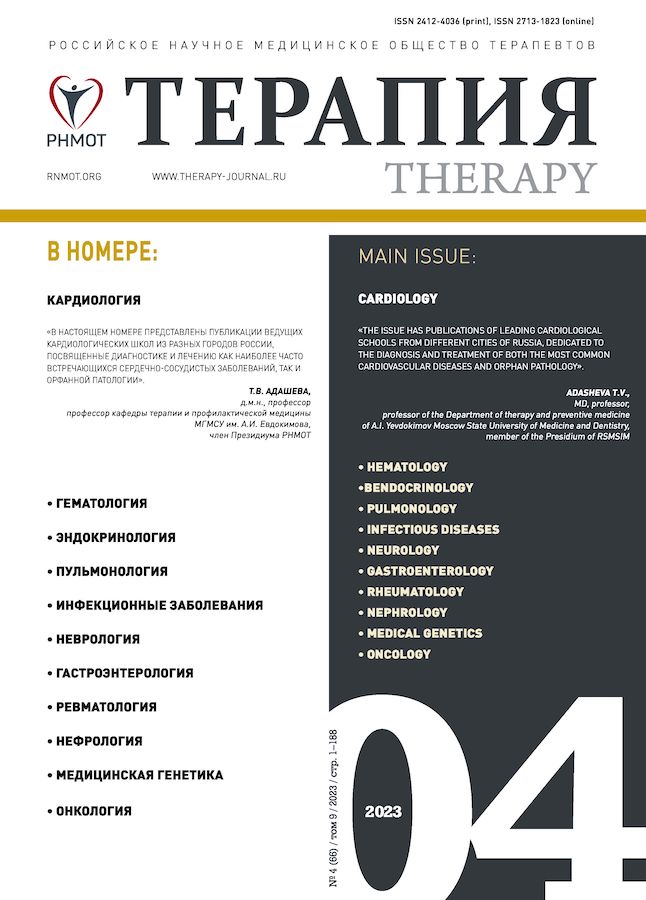Пациенты с сердечно-сосудистыми заболеваниями и прием НПВП: существует ли реальная проблема сегодня?
- Авторы: Ребров А.П.1, Тяпкина М.А.1, Ордякова А.А.1, Юпатов В.Д.1, Кошелева Н.А.1,2, Басов И.В.1,2
-
Учреждения:
- ФГБОУ ВО «Саратовский государственный медицинский университет им. В.И. Разумовского» Минздрава России
- ГУЗ «Областная клиническая больница»
- Выпуск: Том 9, № 4 (2023)
- Страницы: 14-21
- Раздел: ОРИГИНАЛЬНЫЕ ИССЛЕДОВАНИЯ
- URL: https://journals.eco-vector.com/2412-4036/article/view/568853
- DOI: https://doi.org/10.18565/therapy.2023.4.14–21
- ID: 568853
Цитировать
Полный текст
Аннотация
Цель – изучение частоты и особенностей применения нестероидных противовоспалительных препаратов (НПВП) у пациентов с сердечно-сосудистыми заболеваниями (ССЗ), госпитализированных в отделения экстренной кардиологии.
Материал и методы. Обследовано 190 пациентов, госпитализированных в отделения экстренной кардиологии ГУЗ «Областная клиническая больница» г. Саратова с марта по июнь 2022 г. Исследование являлось сплошным, анкетирование проводилось всем пациентам, госпитализированным в указанный период. Анкета содержала вопросы, касающиеся основных и сопутствующих заболеваний, приема НПВП в течение предшествовавшего госпитализации месяца. В исследовании приняли участие 122 мужчины и 68 женщин, средний возраст исследуемых составил 60,75±9,74 лет.
Результаты. В течение месяца перед госпитализацией в отделение экстренной кардиологии НПВП по разным причинам использовали 52% пациентов. Основными причинами госпитализации у большинства пациентов были острая коронарная патология и декомпенсация сердечной недостаточности. В качестве основных причин приема НПВП пациенты отмечают заболевания костно-суставной системы и головную боль. Большинство пациентов (65%) вынуждены принимать НПВП более 1 раза в неделю, 39% пациентов – в течение 3 мес. Одновременно применяли два и более НПВП в течение последнего месяца 26% пациентов.
Заключение. Более половины пациентов, госпитализированных в отделения экстренной кардиологии, в течение предшествующего до госпитализации месяца принимали НПВП. Бόльшая часть пациентов вынуждены использовать НПВП часто, регулярно, продолжительно. В связи с этим требуется активная врачебная тактика выявления факта и уточнения особенностей применения НПВП у данной категории больных. Выбор препаратов у большинства пациентов остается неоптимальным, нередко комбинируются несколько препаратов, разные способы их введения. Таким образом, ситуация с применением НПВП у пациентов с ССЗ требует дополнительного информирования как пациентов, так и врачей об особенностях их использования у этой категории больных.
Полный текст
Об авторах
Андрей Петрович Ребров
ФГБОУ ВО «Саратовский государственный медицинский университет им. В.И. Разумовского» Минздрава России
Автор, ответственный за переписку.
Email: andreyrebrov@yandex.ru
ORCID iD: 0000-0002-3463-7734
д.м.н., профессор, зав. кафедрой госпитальной терапии лечебного факультета
Россия, г. СаратовМария Александровна Тяпкина
ФГБОУ ВО «Саратовский государственный медицинский университет им. В.И. Разумовского» Минздрава России
Email: tyapkina@yandex.ru
ORCID iD: 0000-0002-1860-3171
к.м.н., доцент кафедры госпитальной терапии лечебного факультета
Россия, г. СаратовАнна Александровна Ордякова
ФГБОУ ВО «Саратовский государственный медицинский университет им. В.И. Разумовского» Минздрава России
Email: anna-ordyakova@mail.ru
ORCID iD: 0000-0002-6088-6259
ассистент кафедры госпитальной терапии лечебного факультета
Россия, г. СаратовВладимир Дмитриевич Юпатов
ФГБОУ ВО «Саратовский государственный медицинский университет им. В.И. Разумовского» Минздрава России
Email: bobstersar@gmail.com
ORCID iD: 0000-0001-8599-2990
ассистент кафедры госпитальной терапии лечебного факультета
Россия, г. СаратовНаталья Анатольевна Кошелева
ФГБОУ ВО «Саратовский государственный медицинский университет им. В.И. Разумовского» Минздрава России; ГУЗ «Областная клиническая больница»
Email: kosheleva2009@yandex.ru
ORCID iD: 0000-0001-5585-946X
д.м.н., профессор кафедры госпитальной терапии лечебного факультета, зав. отделением неотложной кардиологии №2
Россия, г. Саратов; г. СаратовИгорь Владимирович Басов
ФГБОУ ВО «Саратовский государственный медицинский университет им. В.И. Разумовского» Минздрава России; ГУЗ «Областная клиническая больница»
Email: basov7373@mail.ru
ассистент кафедры госпитальной терапии лечебного факультета, зав. отделением неотложной кардиологии №3
Россия, г. Саратов; г. СаратовСписок литературы
- Schjerning A.M., McGettigan P., Gislason G. Cardiovascular effects and safety of (non-aspirin) NSAIDs. Nat Rev Cardiol. 2020; 17(9): 574–84. https://dx.doi.org/10.1038/s41569-020-0366-z.
- Wan E.Y.F., Yu Y.E.T., Chan L. et al. Comparative risks of nonsteroidal anti-inflammatory drugs on cardiovascular diseases: A population-based cohort study. J Clin Pharmacol. 2023; 63(1): 126–34. https://dx.doi.org/10.1002/jcph.2142.
- Martin Arias L.H., Martin Gonzalez A., Sanz Fadrique R., Vazquez ES. Cardiovascular risk of nonsteroidal anti-inflammatory drugs and classical and selective cyclooxygenase-2 inhibitors: A meta-analysis of observational studies. J Clin Pharmacol. 2019; 59(1): 55–73. https://dx.doi.org/10.1002/jcph.1302.
- Minhas D., Nidhaan A., Husni M.E. Recommendations for the use of nonsteroidal anti-inflammatory drugs and cardiovascular disease risk: Decades later, any new lessons learned? Rheum Dis Clin North Am. 2023; 49(1): 179–91. https://dx.doi.org/10.1016/j.rdc.2022.08.006.
- Каратеев А.Е., Насонов Е.Л., Ивашкин В.Т. с соавт. Рациональное использование нестероидных противовоспалительных препаратов. Клинические рекомендации. Научно-практическая ревматология. 2018; 56(Прил. 1): 1–29. https://dx.doi.org/10.14412/1995-4484-2018-1-29.
- Ребров А.П., Тяпкина М.А, Кошелева Н.А. Пациенты с сердечно-сосудистыми заболеваниями и прием НПВП: реальная клиническая практика. Архивъ внутренней медицины. 2021; 11(1): 5–10. https://dx.doi.org/10.20514/2226-6704-2021-11-1-5-10.
- Ребров А.П., Григорьева Е.В., Петров Г.С. с соавт. Пациенты, получающие заместительную почечную терапию гемодиализом, и прием НПВС: реальная клиническая практика. Клиническая нефрология. 2021; 4: 43–47. https://dx.doi.org/10.18565/nephrology.2021.4.43-47.
- Sampaio Rocha-Filho P.A. Headache associated with COVID-19: Epidemiology, characteristics, pathophysiology, and management. Headache. 2022; 62(6): 650–56. https://dx.doi.org/10.1111/head.14319.
- Kushner P., McCarberg B.H., Grange L. et al. The use of non-steroidal anti-inflammatory drugs (NSAIDs) in COVID-19. NPJ Prim Care Respir Med. 2022; 32(1): 35. https://dx.doi.org/10.1038/s41533-022-00300-z.
- Khoja O., Silva Passadouro B., Mulvey M. et al. Clinical characteristics and mechanisms of musculoskeletal pain in long COVID. J Pain Res. 2022; 15: 1729–48. https://dx.doi.org/10.2147/JPR.S365026.
- Chung M.K., Zidar D.A., Bristow M.R. et al. COVID-19 and cardiovascular disease: From bench to bedside. Circ Res. 2021 ;128(8): 1214–36. https://dx.doi.org/10.1161/CIRCRESAHA.121.317997.
- Bakılan F., Gokmen I.G., Ortanca B. et al. Musculoskeletal symptoms and related factors in postacute COVID-19 patients. Int J Clin Pract. 2021; 75(11): e14734. https://dx.doi.org/10.1111/ijcp.14734.
- Karaarslan F., Demircioglu Guneri F., Kardes S. Postdischarge rheumatic and musculoskeletal symptoms following hospitalization for COVID-19: prospective follow-up by phone interviews. Rheumatol Int. 2021; 41(7): 1263–71. https://dx.doi.org/10.1007/s00296-021-04882-8.
- Solomon D.H., Husni M.E., Wolski K.E. et al. Differences in safety of nonsteroidal antiinflammatory drugs in patients with osteoarthritis and patients with rheumatoid arthritis: A randomized clinical trial. Arthritis Rheumatol. 2018; 70(4): 537–46. https://dx.doi.org/10.1002/art.40400.
Дополнительные файлы








